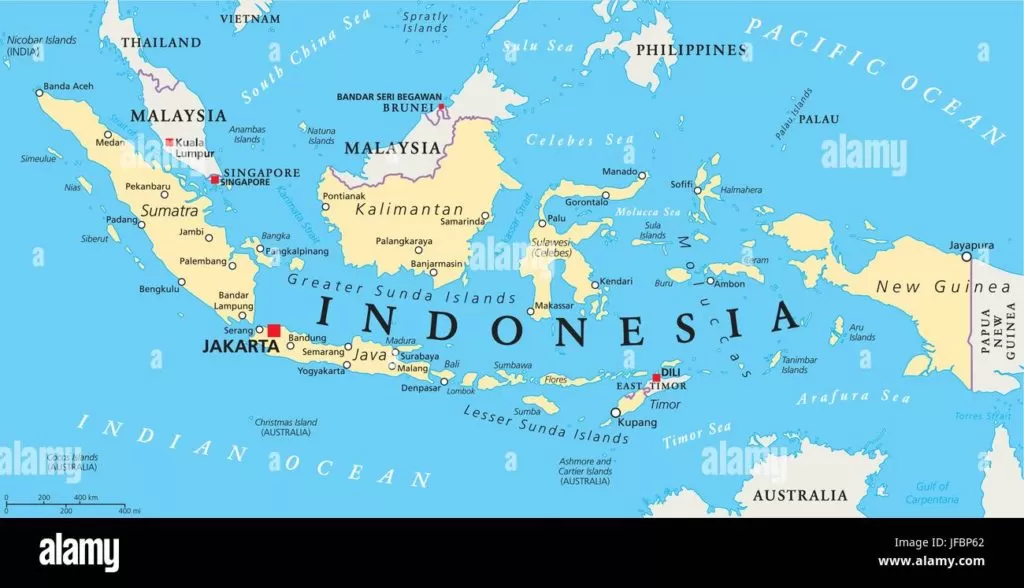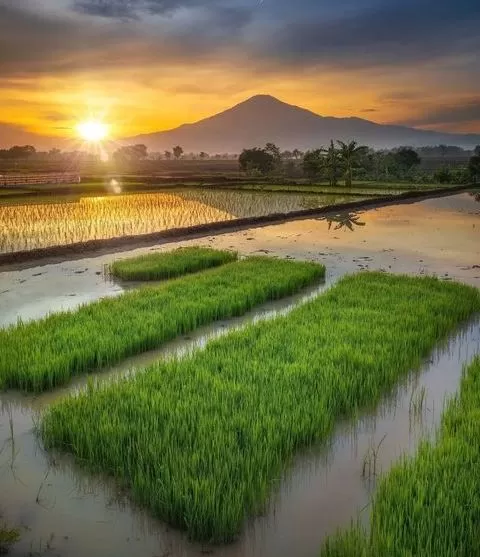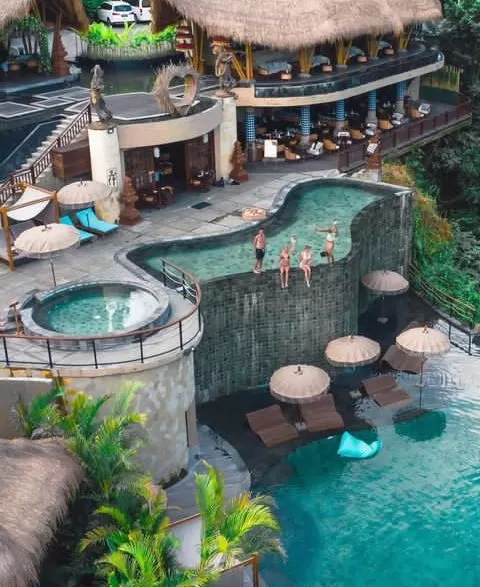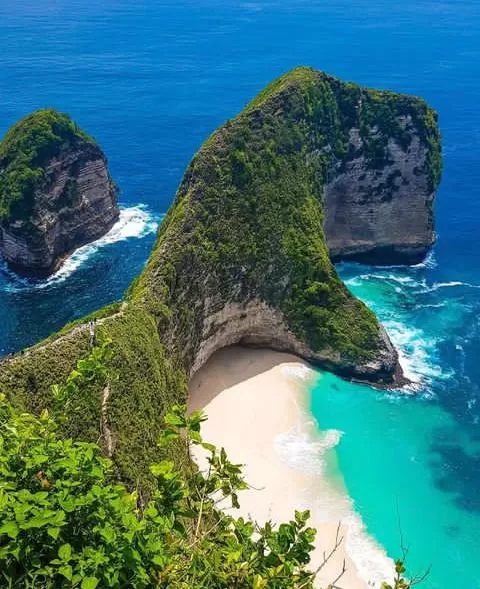Indonesia is known for its Intellectually Diverse culture, influenced by Hinduism and Buddhism, Islam, Chinese, and Dutch cultures, reflecting its varied historical influences.
Where exactly is Indonesia located on a world map?

The Republic of Indonesia, as it is officially called, is located in the Southeast of Asia. It lies exactly between the Pacific and the Indian Ocean. On the world map, it lies on the latitude and longitude 3.2591° S, 109.7028° E. According to the Indonesian map, it is an archipelago of islands covering 735,358 square miles (1,904,568 sq km) in total. Indonesia with this large area therefore makes it the largest island country in the world.
Recommended reading….Indonesia Travel Restrictions For Foreigners
What 6 countries make up Indonesia?
The name Indonesia derives from Greek meaning “Indian islands”. It is an Island made up 6 Islands as countries which form the country Indonesia. They are Java, Sumatra, Kalimantan, Sulawesi, Lesser Sunda Islands and Maluku Islands.
The country shares borders with Malaysia on Borneo Island with Papua New Guinea on Papua Island, and with East Timor on Timor Island. Countries like Singapore, the Philippines, Australia, and the union territory of the Andaman and Nicobar Islands in India are other neighboring countries to Indonesia. In terms of maritime, Singapore, Vietnam, the Philippines, Australia, Palau, and India are the bordering countries to Indonesia.
With over 267 million populations, Indonesia is the fourth most populous country in the world. The most populated island is Java which contains 58% of the total population. It is also known for having the largest population of Muslims in the world. On account of the great development among the various regions or areas of the Islands, the population spread is not stable.
Jakarta used to be the capital city but there is a new bill which has been approved to change the new capital to Nusantara formerly East Kalimantam. Jakarta is a bustling and crowded city with architectural wonders like its old town, the national monument, Monas, government buildings like the Presidential Palace, and several major theme parks, including the country’s largest, Jungleland Sentul City. Jakarta has cultural sites like museums, mosques, churches, and open-air markets.
Other major cities include Banjarmasin, Medan, Semarang and Jayapura. Jakarta is a well-developed metropolitan area, while Papua which is Indonesia’s easternmost province is where varieties of tribes are inhabited.
History of Indonesia

According to historians, fossil remains of Homo erectus or humans, popularly known as the “Java Man”, suggest the Indonesian archipelago was inhabited two million to 500,000 years ago. They believed that an outrigger boats from the archipelago may have made trade voyages to the east coast of Africa as early as the 1st century CE. The homo sapiens reached the region around 43,000 BCE. Austronesian peoples, who form the majority of the modern population, migrated to Southeast Asia from what is now Taiwan.
They arrived in the archipelago around 2,000 BCE and confined the native Melanesian peoples to the far eastern regions as they spread east. Ideal agricultural conditions and the mastering of wet-field rice cultivation as early as the eighth century BCE allowed villages, towns, and small kingdoms to flourish by the first century CE.
The archipelago’s strategic sea-lane position fostered inter-island and international trade, including with Indian kingdoms and Chinese dynasties, from several centuries BCE. Trade has since fundamentally shaped Indonesian history.
Around the seventh century onward, the Srivijaya naval kingdom flourished due to trade and the influences of Hinduism and Buddhism. Between the eighth and tenth centuries CE, the agricultural Buddhist Sailendra and Hindu Mataram dynasties thrived and declined in inland Java, leaving grand religious monuments such as Sailendra’s Borobudur and Mataram’s Prambanan.
The Hindu Majapahit kingdom was founded in eastern Java in the late 13th century, and under Gajah Mada, its influence stretched over much of present-day Indonesia. This period is often referred to as a “Golden Age” in Indonesian history.
The earliest evidence of Islamized populations in the archipelago dates to the 13th century in northern Sumatra. Other parts of the archipelago gradually adopted Islam, and it was the dominant religion in Java and Sumatra by the end of the 16th century. For the most part, Islam overlaid and mixed with existing cultural and religious influences, which shaped the predominant form of Islam in Indonesia, particularly in Java.
The first Europeans arrived in the archipelago in 1512, when Portuguese traders, led by Francisco Serrão, sought to monopolise the sources of nutmeg, cloves, and cubeb pepper in the Maluku Islands. Dutch and British traders followed. In 1602, the Dutch established the Dutch East India Company (VOC) and became the dominant European power for almost 200 years. The VOC was dissolved in 1800 following bankruptcy, and the Netherlands established the Dutch East Indies as a nationalised colony.
For most of the colonial period, Dutch control over the archipelago was tenuous. Dutch forces were engaged continuously in quelling rebellions both on and off Java. The influence of local leaders such as Prince Diponegoro in central Java, Imam Bonjol in central Sumatra, Pattimura in Maluku, and the bloody 30-year war in Aceh weakened the Dutch and tied up the colonial military forces. Only in the early 20th century did Dutch dominance extend to what was to become Indonesia’s current boundaries.
The Japanese invasion and subsequent occupation during World War II ended Dutch rule and encouraged the previously suppressed independence movement. Two days after the surrender of Japan in August 1945, Sukarno and Mohammad Hatta, influential nationalist leaders, proclaimed Indonesian independence and were appointed president and vice-president, respectively.
The Netherlands attempted to re-establish their rule, and a bitter armed and diplomatic struggle ended in December 1949 when the Dutch formally recognised Indonesian independence in the face of international pressure and transferred sovereignty to the United States of Indonesia. Despite extraordinary political, social and sectarian divisions, Indonesians, on the whole, found unity in their fight for independence.
As president, Sukarno moved Indonesia from democracy towards authoritarianism and maintained power by balancing the opposing forces of the military, political Islam and the increasingly powerful Communist Party of Indonesia (PKI).Tensions between the military and the PKI culminated in an attempted coup in 1965.
The army led by Major General Suharto, countered by instigating a violent anti-communist purge that killed between 500,000 and one million people. The PKI was blamed for the coup and effectively destroyed. Suharto capitalized on Sukarno’s weakened position, and following a drawn-out power play with Sukarno, Suharto was appointed president in March 1968. His “New Order” administration, supported by the United States, encouraged foreign direct investment, which was a crucial factor in the subsequent three decades of substantial economic growth.
Indonesia was the country hardest hit by the 1997 Asian financial crisis. It brought out popular discontent with the New Order’s corruption and suppression of political opposition and ultimately ended Suharto’s presidency. In 1999, East Timor seceded from Indonesia, following its 1975 invasion by Indonesia and a 25-year occupation marked by international condemnation of human rights abuses.
Since 1998, democratic processes have been strengthened by enhancing regional autonomy and instituting the country’s first direct presidential election in 2004.
Indonesia now, is the founder of numerous significant organizations such as Non-Aligned Movement, Association of Southeast Asian Nations, Asia-Pacific Economic Cooperation, East Asia Summit and Asian Infrastructure Investment Bank and Organization of Islamic Cooperation.
Recommended.. Staying in Indonesia on budget accommodation
Attractions of Indonesia

In terms of the beauty of Indonesia, there are lots of attractions that make the country worth visiting. It is an abode where there is a mixture of influenced by Hinduism and Buddhism, Islam, Chinese, and Dutch cultures. With Indonesian as the official spoken language, there are many languages from the various beautiful tribes in the country.
There are many natural sites including the second largest tropical forests in the world, including those on Sumatra, Borneo and Papua which are clearly marked on the Indonesia Map. The rain forests on Borneo are 130 million years old and are some of the oldest in the world.
The beaches of Bali are the most popular destination in Indonesia, with water recreation like surfing, and historical and architectural sites.
There are also the Komodo dragon which is known be the world’s largest dragon in the various Islands of Indonesia. They weigh about 150lbs and they not only look scary but are indeed poisonous.
The markets of Indonesia are a great place to explore Indonesian culture, with handicrafts and local foods.
Thank you for reading this article.
Related articles
Travel Guide And Things To Do At The Victoria Falls
Things To Know About Nigeria Culture
Interesting Facts You Need To Know About Tanzania In Africa
Kenya Tourism: 16 Top Attractions To Visit
Top Best Tourist Sites In Ghana To Visit
Best Bali Beaches In Indonesia
The Best 17 Bali Indonesia Resorts
Is bali in Indonesia: Where is Located On The Map

